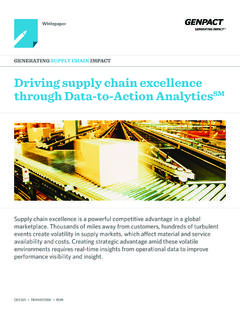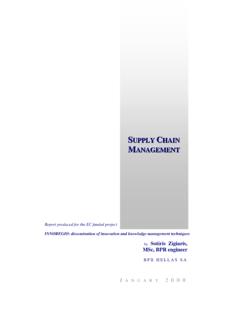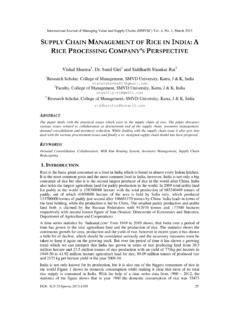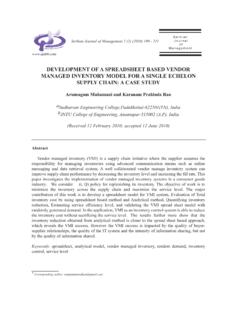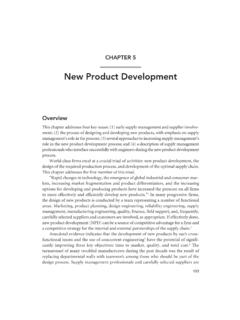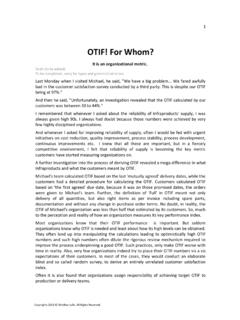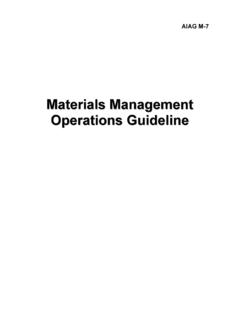Transcription of Supply-Chain Operations Reference-model - EDI Guys
1 PLAN SOURCE MAKE DELIVER OverviewSupply- chain OperationsReference-modelSCOR is a registered trademark of the Supply-Chain Council in the United States and EuropeSCOR OverviewThe Supply-Chain Operations Reference-model (SCOR) is the product of the supply -ChainCouncil (SCC), an independent, not-for-profit, global corporation with membership open toall companies and organizations interested in applying and advancing the state-of-the-art insupply- chain management systems and practices. The SCOR- model captures the Council sconsensus view of supply chain management. While much of the underlying content of theModel has been used by practitioners for many years, the SCOR- model provides a uniqueframework that links business process, metrics, best practices and technology features into aunified structure to support communication among supply chain partners and to improve theeffectiveness of supply chain management and related supply chain improvement companies pay a modest annual fee to support Council activities.
2 All who use theSCOR- model are asked to acknowledge the SCC in all documents describing or depicting theSCOR- model and its use. The complete SCOR- model and other rleated models of the SCCare accessable through the members section of SCCmembers further model development by participating in project development teams- SCORand other related SCC Models are collaborative ongoing projects that seek to represent current supply chain and related practice. Copyright 2008 Supply-Chain CouncilSupply- chain OperationsReference-modelTABLE OFCONTENTST able of ContentsSection One:What is a Process reference model ?1 Section Two: model Scope and Structure3 Section Three: Applying the Model15 The Concept of Configurability15 Modeling with SCOR16 Business Scope Diagram17 Geographic Map18 Thread Diagram19 Process Models20 Further information regardingmembership, the Council andSCORcan be found at the Council s web site.
3 Overview1 Capture the as-is state of a processand derive thedesired to-be future stateQuantify the operational performance of similar companiesand establish internal targetsbased on best-in-class resultsCharacterize themanagement practices and software solutionsthat result in best-in-class performanceCapture the as-is state of aprocess and derive the desired to-be future stateQuantify the operational performance of similar companiesand establish internal targets basedon best-in-class resultsCharacterize the management practices and software solutionsthat result in best-in-class performanceBusinessProcessReengineeringB enchmarkingBest PracticesAnalysisProcess reference ModelWhat Is a Process reference model ?Process reference models integrate the well-known concepts of business process reengi-neering, benchmarking, and process measurement into a cross-functional Overview2A Process reference model Contains: Standard descriptions of management processes A framework of relationships among the standard processes Standard metrics to measure process performance Management practices that produce best-in-class performance Standard alignment to features and functionalityOnce a Complex Management Process is Captured in Standard Process reference model Form, It can Be.
4 Implemented purposefully to achieve competitive advantage Described unambiguously and communicated Measured, managed, and controlled Tuned and re-tuned to a specific purposeA Process reference model Becomes a Powerful Tool in the Hands of ManagementSCOR OverviewDeliverDeliverDeliverDeliverSour ceSourceSourceSourceMakeMakeMakePlanSupp liers SupplierSupplierYour CompanyCustomerCustomer sCustomerInternal or ExternalInternal or ExternalReturnReturnReturnReturnReturnRe turnReturnReturnPlanPlanSectionTWO3 ModelScope and StructureThe Boundaries of Any model Must Be Carefully Defined From your supplier s supplier to your customer s customer SCOR spans: All customer interactions, from order entry through paid invoice All product (physical material and service) transactions, from your supplier s supplier to yourcustomer s customer, including equipment, supplies, spare parts, bulk product, software, etc.
5 All market interactions, from the understanding of aggregate demand to the fulfillment of each orderSCOR does not attempt to describe every business process or activity, including: Sales and marketing (demand generation) Research and technology development Product development Some elements of post-delivery customer supportLinks can be made to processes not included within the model s scope, such as product development, andsome are noted in assumes but does not explicitly address: Training Quality Information Technology (IT) Administration (non SCM)SCOR Overview4 Demand/ supply Planning and ManagementBalance resources with requirements and establish/communicate plans for the whole supplychain, including Return, and the execution processes of Source, Make, and Deliver.
6 Management of business rules, supply chain performance, data collection, inventory, capitalassets, transportation, planning configuration, regulatory requirements and compliance, and sup-ply chain the supply chain unit plan with the financial Stocked, Make-to-Order, and Engineer-to-Order ProductSchedule deliveries; receive, verify, and transfer product; and authorize supplier payments. Identify and select supply sources when not predetermined, as for engineer-to-order product. Manage business rules, assess supplier performance, and maintain data. Manage inventory, capital assets, incoming product, supplier network, import/export requirements, supplier agreements, and supply chain source , Make-to-Order, and Engineer-to-Order Production ExecutionSchedule production activities, issue product, produce and test, package, stage product, andrelease product to deliver.
7 With the addition of Green to SCOR, there are now processes specifi-cally for Waste Disposal in engineering for engineer-to-order product. Manage rules, performance, data, in-process products (WIP), equipment and facilities, transporta-tion, production network, regulatory compliance for production, and supply chain make of SCOR ProcessesMakeSCOR is Based on Five Distinct Management ProcessesSCOR Overview5 Order, Warehouse, Transportation, and Installation Managementfor Stocked, Make-to-Order, and Engineer-to-Order ProductAll order management steps from processing customer inquiries and quotes to routing shipments and selecting carriers. Warehouse management from receiving and picking product to load and ship product. Receive and verify product at customer site and install, if necessary.
8 Invoicing customer. Manage Deliver business rules, performance, information, finished product inventories, capitalassets, transportation, product life cycle, import/export requirements, and supply chain of Raw Materials and Receipt of Returns of Finished GoodsAll Return Defective Product steps from source identify product condition, disposition product,request product return authorization, schedule product shipment, and return defective product and deliver authorized product return, schedule return receipt, receive product, and transfer defective Return Maintenance, Repair, and Overhaul product steps from source identify product condition, disposition product, request product return authorization, schedule product shipment,and return MRO product and deliver authorize product return.
9 Schedule return receipt, receiveproduct, and transfer MRO Return Excess Product steps from source identify product condition, disposition product,request product return authorization, schedule product shipment, and return excess product and deliver authorize product return, schedule return receipt, receive product, and transfer excess Return business rules, performance, data collection, return inventory, capital assets, transportation, network configuration, regulatory requirements and compliance, and supply chainreturn Overview6A Process reference model Differs from Classic ProcessDecomposition ModelsLevel1234 Contains:Process TypeProcess CategoryProcess CategoryProcess ElementProcess ElementActivitiesActivitiesProvide a balanced horizontal (cross-process)and vertical (hierarchical)viewDesigned to be (re)configurableUsed to represent many different configurations ofa similar processAggregate a series of hierarchical process modelsProcess decomposition models are developed to address one specific configuration of process elementsSCOR Overview7 Supply-Chain Operations reference -modelNotinScopeLevel 1 defines the scope and content for the supply chain OperationsReference- model .
10 Here basis of competition performance targets are company s supply chain can be configured-to-order at Level 2 fromcore process categories. Companiesimplement their Operations strategythrough the configuration they choosefor their supply 3 defines a company s ability tocompete successfully in its chosen markets, and consists of: Process element definitions Process element information inputs, and outputs Process performance metrics attributes and defintions Best practices definitionsCompanies fine tune their OperationsStrategy at Level implement supply -chainmanagement practices that are uniqueto their organizations at this level. Level4 and lower defines specific practices toachieve competitive advantage and toadapt to changing business Level(Process Types)ConfigurationLevel (ProcessCategories)Process ElementLevel(DecomposeProcesses)Implemen tationLevel(DecomposeProcessElements)
